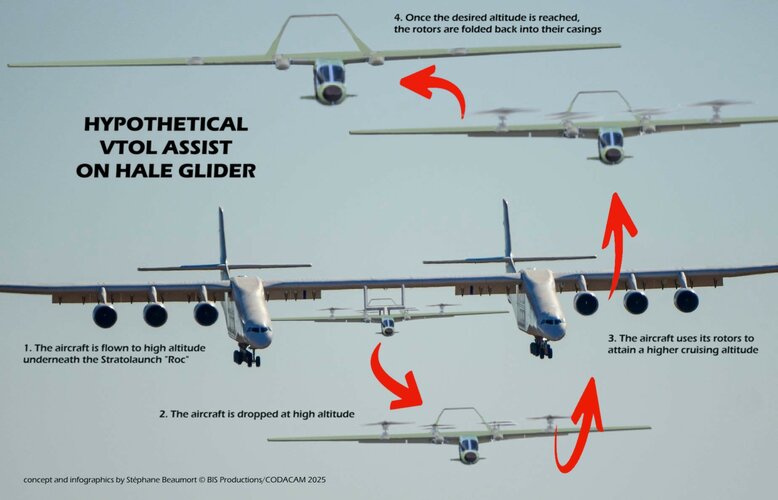- Joined
- 25 June 2009
- Messages
- 14,749
- Reaction score
- 6,112
Since my previous post, I've had a thought on my mind that I'd like to share, and would be interested to hear your comments/criticism about it: I initially discarded the Scaled Composites Model 432 because it was registered as a glider. But would it be possible to build an aircraft of that size strictly as a glider, to fly it as such, but also to fly it with optional rotors? The shape of the wings and their roots seem somewhat compatible with those of a glider. If they were short, there wouldn't be a need for them to be tapered, but if we prolong the wings in the photo we can see that they taper out like those of a regular aircraft.
So, what if the mysterious Mojave aircraft is basically a glider, but with optional rotors than can be bolted onto it? Would it have to be registered from the start as a six-engine vehicle with FAA? Since the trials are probably only done in VTOL mode, it seems possible that the aircraft could be registered as a glider, but be tested in VTOL mode within an enclosed perimeter and therefore not require a change in its registration details since it won't be flown over cities or public areas.
Final thought: everyone's been commenting on the fact that it has six rotors/engines. But don't forget: we can't see the parts of the wings that are hidden by the hangars, so for all we know there could be more. Six rotors for an aircraft of that size seems insufficient, unless 1°) there are more hidden in the photo, or 2°) the aircraft is not a pure VTOL type and the rotors are optional. Also we can see that two of the visible rotors are large, while the other four are smaller. So IF my optional rotor theory stands, they could be tried in different numbers and positions various rotor to find the optimal configuration (which could change depending on the mission). Okay, I'll admit this particular idea seems a little far-fetched, but if that is really a Scaled product, we know the company has made a specialty of thinking outside the box!
I love the fact that we are all making more or less educated guesses but could all be proven wrong. That's one of the things I find especially interesting on this forum, and it doesn't happen so often nowadays (the Otto Celera was another example). To further my glider theory, I'm proposing here a possible explanation to VTOL lift on what seems to be a high-altitude glider: what if the glider is a to be a HALE platform, to be dropped from the Roc carrier, and the VTOL system is meant to take it to higher altitudes, or change its altitude at will? I don't buy the transport theory myself, because of the very short fuselage (evidenced by the lowered flaps which actually cover part of the fuselage's rear).
The following infographics should NOT be taken for anything else but pure hypothesis on my part. Nothing concrete to substantiate it!


So, what if the mysterious Mojave aircraft is basically a glider, but with optional rotors than can be bolted onto it? Would it have to be registered from the start as a six-engine vehicle with FAA? Since the trials are probably only done in VTOL mode, it seems possible that the aircraft could be registered as a glider, but be tested in VTOL mode within an enclosed perimeter and therefore not require a change in its registration details since it won't be flown over cities or public areas.
Final thought: everyone's been commenting on the fact that it has six rotors/engines. But don't forget: we can't see the parts of the wings that are hidden by the hangars, so for all we know there could be more. Six rotors for an aircraft of that size seems insufficient, unless 1°) there are more hidden in the photo, or 2°) the aircraft is not a pure VTOL type and the rotors are optional. Also we can see that two of the visible rotors are large, while the other four are smaller. So IF my optional rotor theory stands, they could be tried in different numbers and positions various rotor to find the optimal configuration (which could change depending on the mission). Okay, I'll admit this particular idea seems a little far-fetched, but if that is really a Scaled product, we know the company has made a specialty of thinking outside the box!
I love the fact that we are all making more or less educated guesses but could all be proven wrong. That's one of the things I find especially interesting on this forum, and it doesn't happen so often nowadays (the Otto Celera was another example). To further my glider theory, I'm proposing here a possible explanation to VTOL lift on what seems to be a high-altitude glider: what if the glider is a to be a HALE platform, to be dropped from the Roc carrier, and the VTOL system is meant to take it to higher altitudes, or change its altitude at will? I don't buy the transport theory myself, because of the very short fuselage (evidenced by the lowered flaps which actually cover part of the fuselage's rear).
The following infographics should NOT be taken for anything else but pure hypothesis on my part. Nothing concrete to substantiate it!


Last edited:
